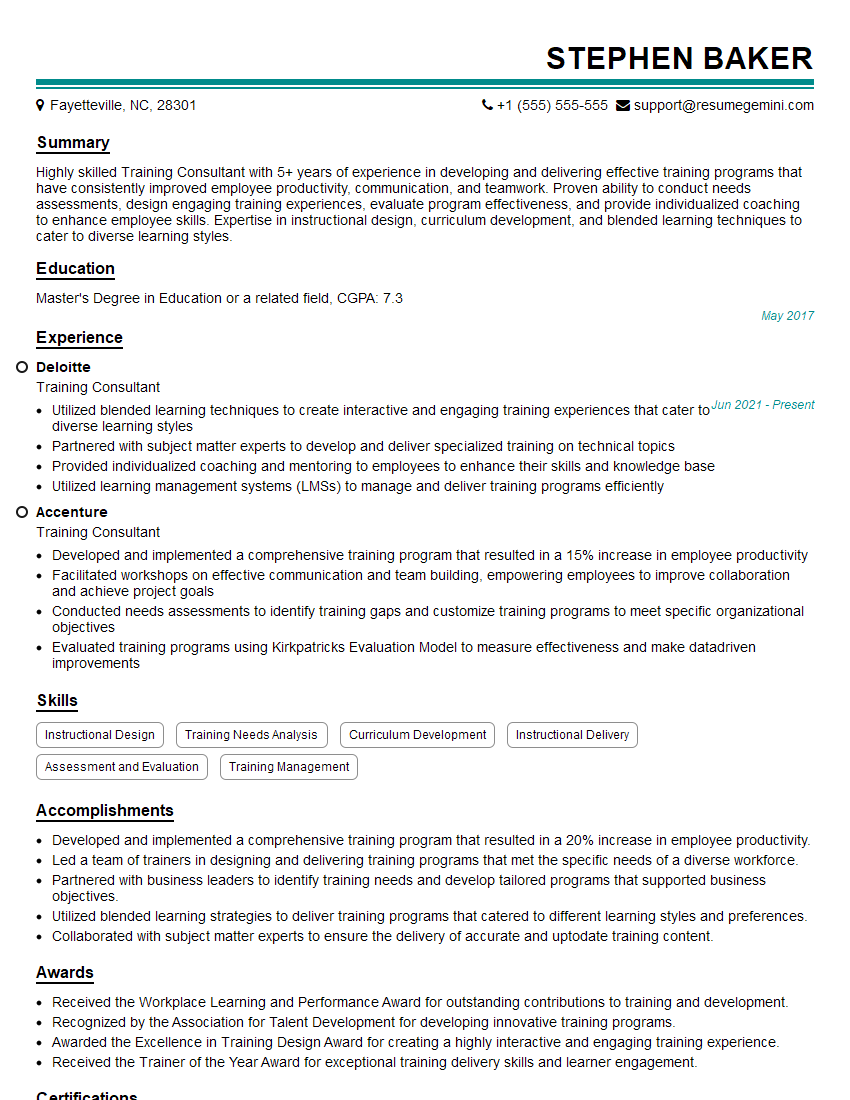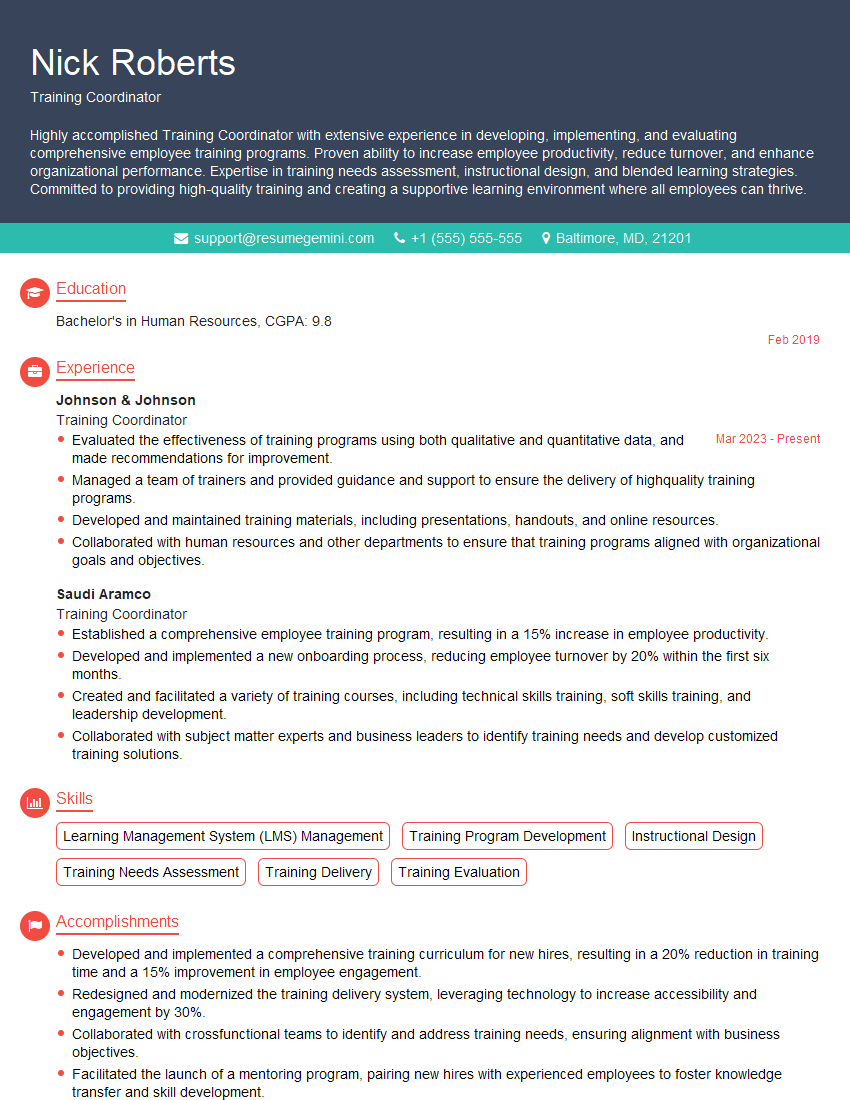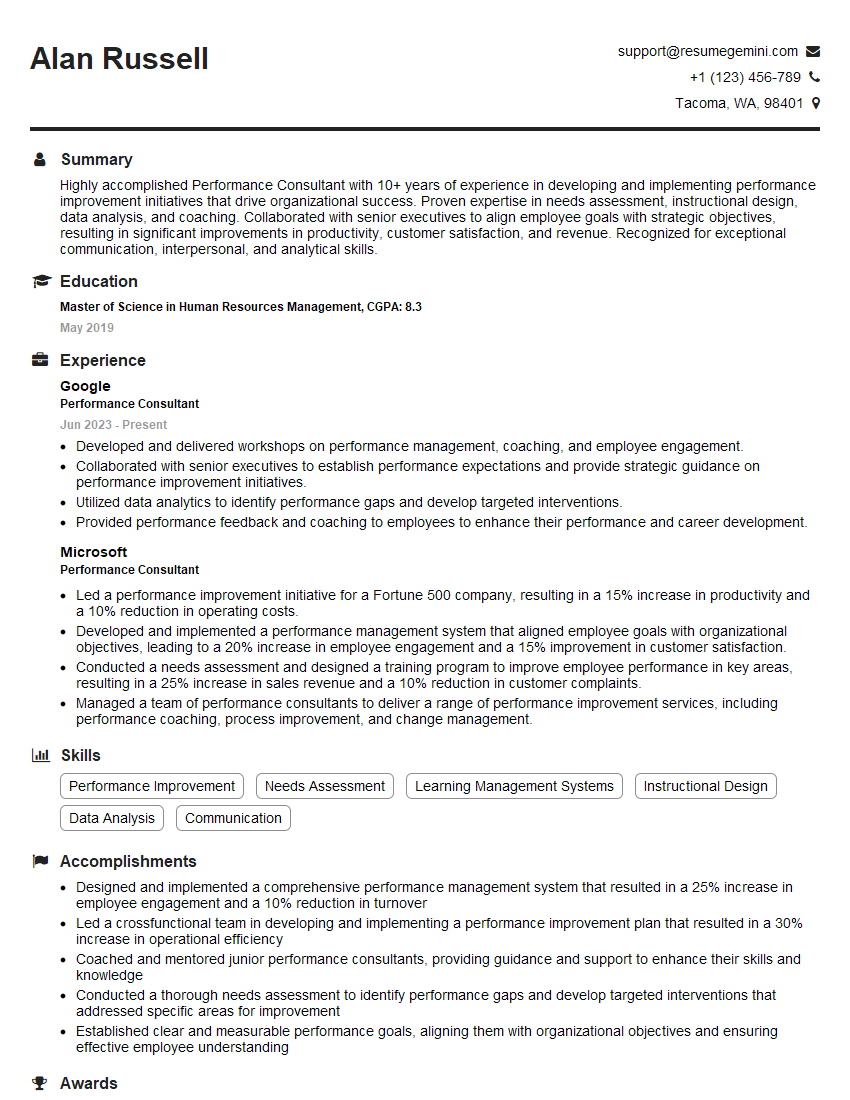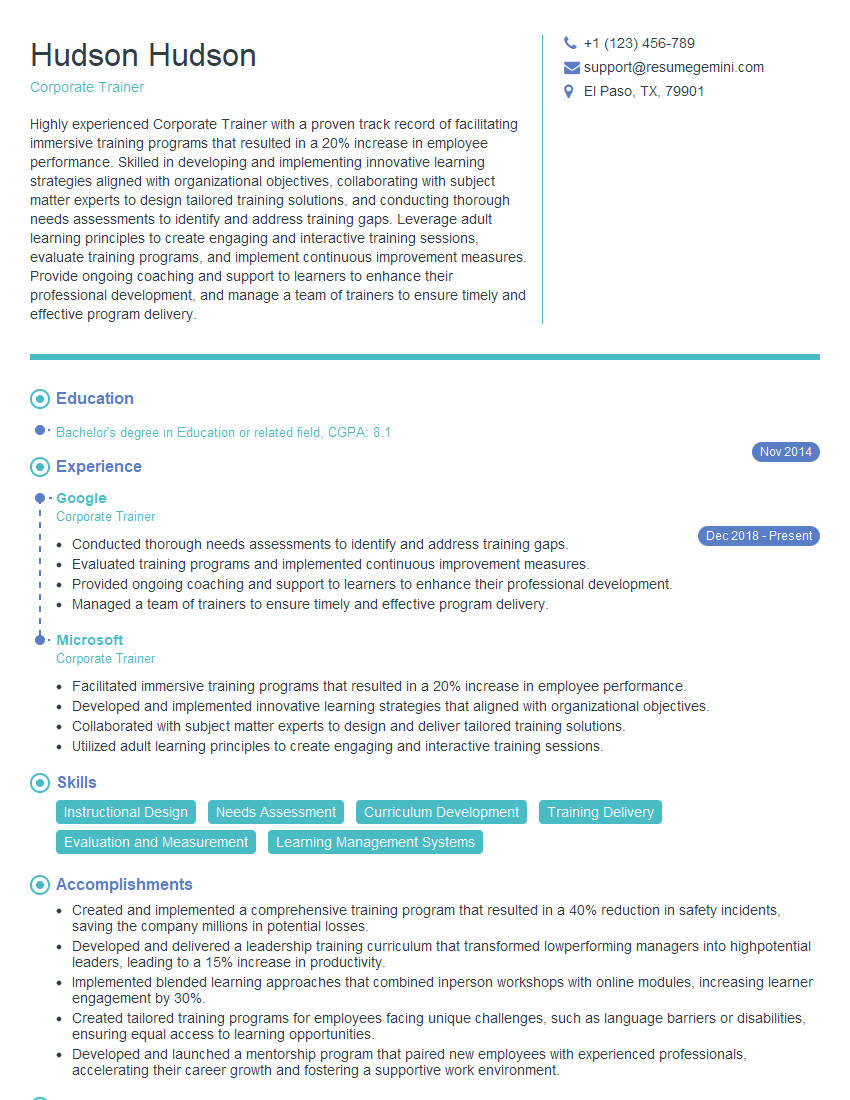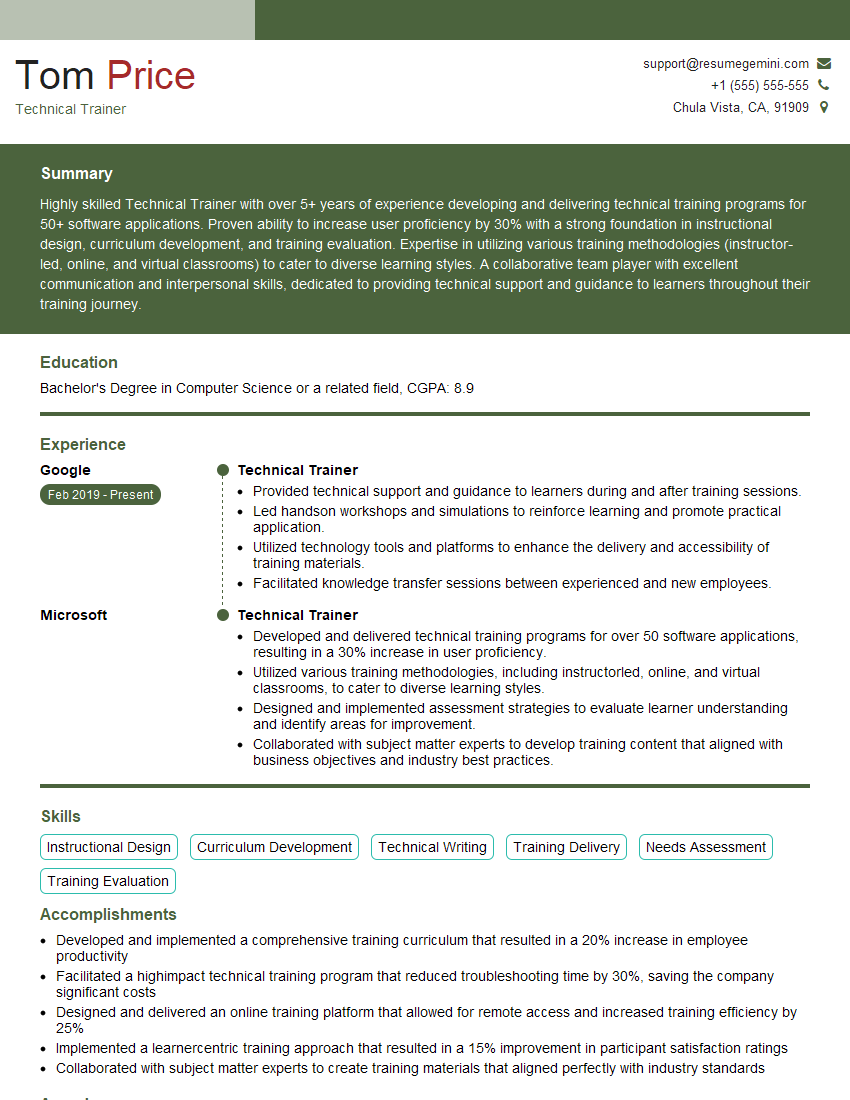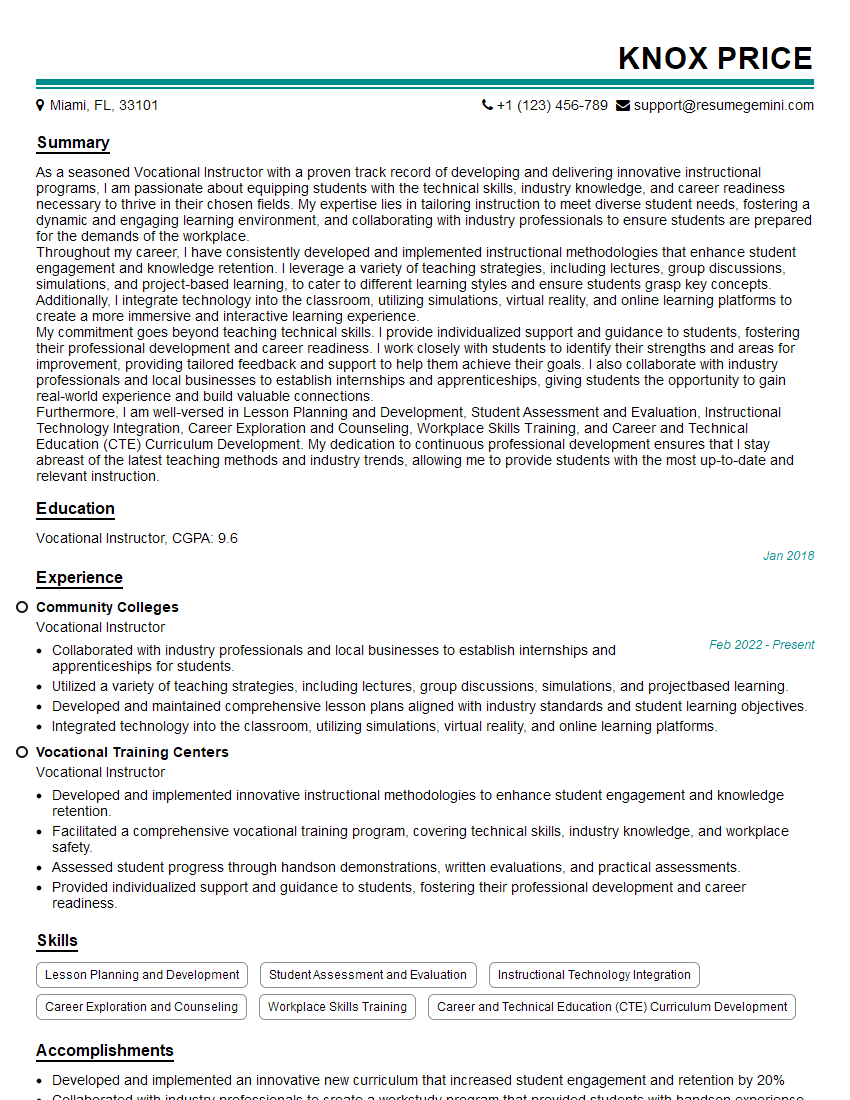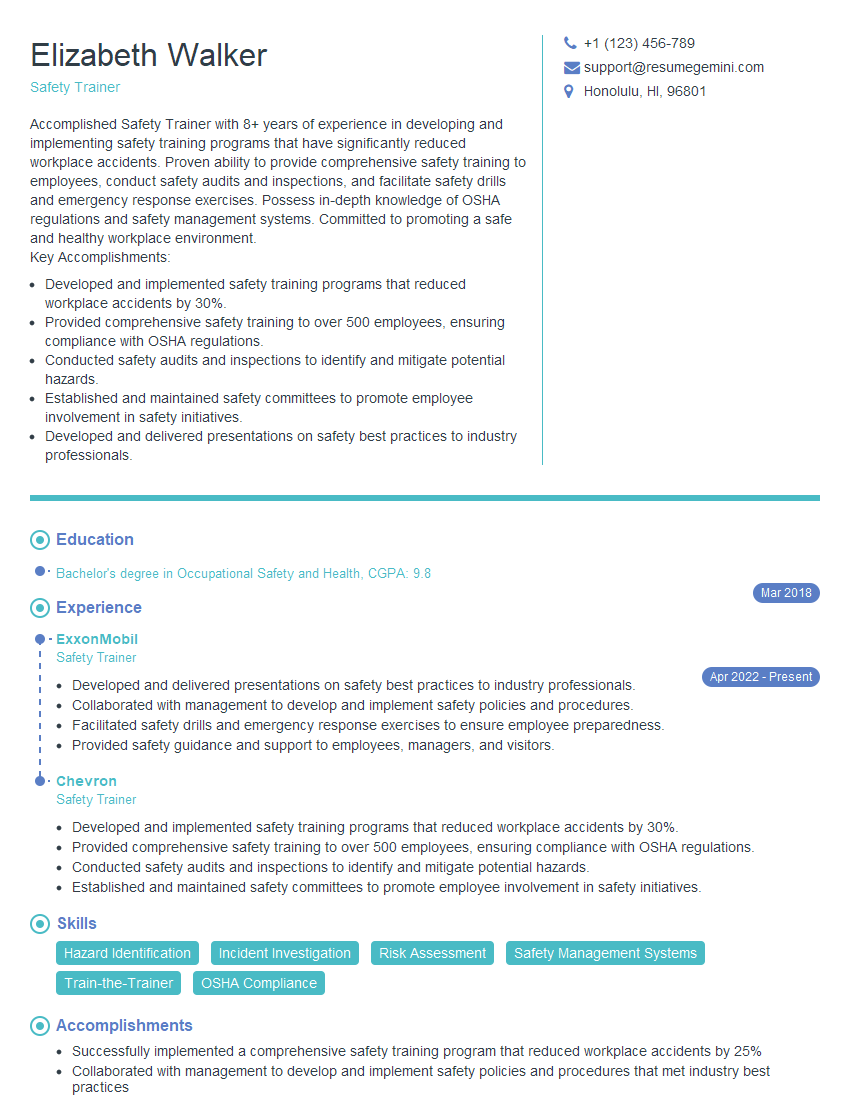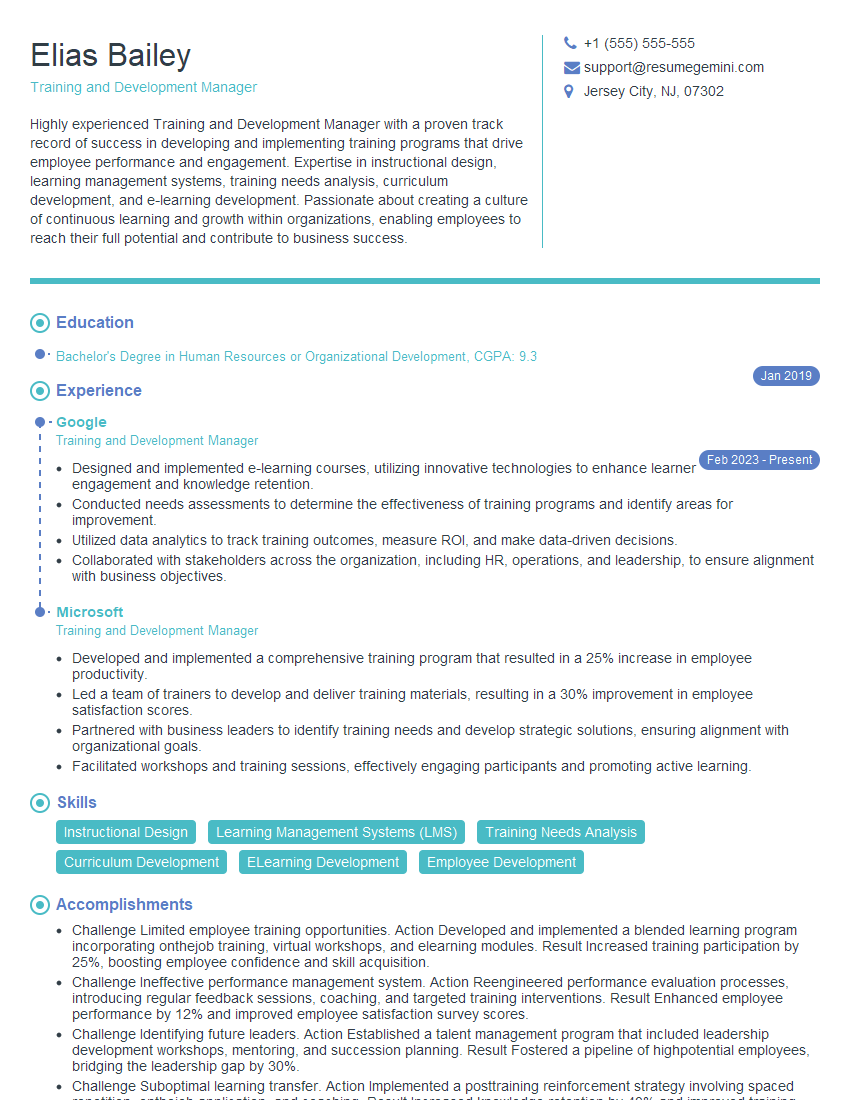The thought of an interview can be nerve-wracking, but the right preparation can make all the difference. Explore this comprehensive guide to Industry Training interview questions and gain the confidence you need to showcase your abilities and secure the role.
Questions Asked in Industry Training Interview
Q 1. Describe your experience designing and delivering training programs.
Designing and delivering training programs is a multifaceted process requiring a deep understanding of adult learning principles, instructional design, and the specific needs of the target audience. My approach involves a systematic process, beginning with a thorough needs analysis (discussed further in the next answer) to identify learning gaps and objectives. I then develop a curriculum that incorporates a variety of learning methods, ensuring engagement and knowledge retention. This could involve creating engaging presentations, interactive workshops, hands-on activities, or simulations, depending on the subject matter and learning style of the participants. For example, when developing a training program on new software for a group of accountants, I would include practical exercises where they apply the new software to realistic accounting scenarios. Following the delivery, I always evaluate effectiveness to make improvements for future iterations.
Recently, I designed a comprehensive safety training program for a manufacturing plant. This involved analyzing accident reports, interviewing workers, and conducting job shadowing to pinpoint areas needing improvement. The resulting program incorporated interactive modules on hazard identification, risk assessment, and emergency procedures, culminating in a practical safety audit simulation. The program significantly reduced workplace accidents post-implementation.
Q 2. Explain your methodology for needs analysis in industry training.
My needs analysis methodology is a crucial first step in any training program. It ensures the training is relevant, effective, and addresses the actual needs of the organization and its employees. This typically involves a multi-pronged approach:
- Gathering data: This includes reviewing existing documentation (e.g., performance reviews, accident reports), conducting surveys, and conducting interviews with managers, employees, and subject matter experts (SMEs). The goal is to identify performance gaps, skill deficiencies, and areas where training can improve productivity or safety.
- Analyzing data: Once data is collected, I analyze it to identify patterns and trends. This helps pinpoint specific training needs and learning objectives. For instance, if performance reviews consistently highlight weaknesses in a particular skill, that skill becomes a priority for training.
- Prioritizing needs: Based on the analysis, I prioritize training needs based on their impact on the organization’s goals and the urgency of addressing them. A critical safety issue would take precedence over a less urgent skill enhancement.
- Defining learning objectives: Finally, I define specific, measurable, achievable, relevant, and time-bound (SMART) learning objectives. This clarity ensures that the training effectively addresses the identified needs and produces tangible results. For example, instead of a vague objective like ‘improve communication skills,’ a SMART objective might be ‘Participants will be able to effectively communicate project updates in a team meeting, using clear and concise language, by the end of the training.’
Q 3. How do you assess the effectiveness of a training program?
Assessing training effectiveness is vital to ensure return on investment and program improvement. My assessment strategy involves both formative and summative evaluation methods:
- Formative Evaluation (during training): This involves ongoing monitoring and feedback throughout the training process. I use methods like quizzes, observations, and informal feedback sessions to gauge participant understanding and make adjustments as needed. This ensures that the training is on track and that learners are grasping the material.
- Summative Evaluation (after training): This involves assessing the impact of the training after its completion. Methods include post-training tests, performance evaluations, and surveys to measure changes in knowledge, skills, and behavior. For example, I might track employee performance metrics before and after safety training to determine its impact on workplace accidents. I also often gather feedback on the training’s overall effectiveness and areas for improvement.
The data gathered through both formative and summative evaluations informs future training iterations, ensuring continuous improvement and maximum impact.
Q 4. What are your preferred methods for delivering training (e.g., online, in-person, blended)?
My preferred method for delivering training is a blended learning approach, combining the benefits of online and in-person instruction. This approach offers flexibility and caters to diverse learning styles.
- Online learning (eLearning): Offers flexibility, accessibility, and cost-effectiveness. I use eLearning platforms to deliver self-paced modules, interactive simulations, and online assessments. This allows learners to review materials at their own pace and access them anytime, anywhere.
- In-person training: Facilitates interactive learning, collaboration, and networking. In-person sessions are ideal for hands-on activities, group discussions, and personalized feedback. The face-to-face interaction fosters a sense of community and allows for immediate clarification of doubts.
- Blended Learning: Combining both methods provides a comprehensive learning experience. For example, learners might complete online modules before attending an in-person workshop, allowing them to come prepared and focus on interactive exercises and discussions during the workshop.
The optimal delivery method depends on the training’s objectives, the target audience, and the available resources. I always strive to choose the most effective and engaging method for the specific context.
Q 5. How do you adapt training materials for diverse learning styles?
Adapting training materials for diverse learning styles is crucial for maximizing engagement and knowledge retention. I utilize various strategies to cater to visual, auditory, and kinesthetic learners:
- Visual Learners: I incorporate visual aids such as diagrams, charts, videos, and infographics. Clear and concise presentations with strong visual elements are essential.
- Auditory Learners: I incorporate audio components, such as podcasts, lectures, and discussions. Providing opportunities for verbal participation and group work enhances their learning experience.
- Kinesthetic Learners: I incorporate hands-on activities, simulations, role-playing, and practical exercises. This ensures active participation and allows learners to apply their knowledge in a practical context.
I also ensure that the training materials are accessible to learners with different levels of digital literacy and technological access. This might involve providing alternative formats for materials and offering both online and offline options where appropriate.
Q 6. Describe your experience with eLearning development platforms and tools.
I have extensive experience with various eLearning development platforms and tools, including Articulate Storyline, Adobe Captivate, and Moodle. My experience extends beyond simply using these platforms; I understand how to leverage their features to create engaging and effective online learning experiences. For example, I utilize Articulate Storyline’s branching scenarios to create interactive learning paths that adapt to learner responses, providing personalized feedback and ensuring knowledge reinforcement.
Beyond the specific platforms, I’m also proficient in using various multimedia tools for creating engaging content, such as video editing software and graphic design tools. This allows me to create visually appealing and informative learning materials that capture and maintain learner attention.
Q 7. How do you incorporate adult learning principles into your training design?
Incorporating adult learning principles is fundamental to my training design. Adults learn differently from children; they are self-directed, bring prior experience to the learning process, and are motivated by relevance and practical application. Therefore, my approach emphasizes the following principles:
- Andragogy (adult learning theory): I design training that is relevant to learners’ experiences and needs. This involves actively engaging learners in the design process, using case studies and real-world examples, and encouraging self-directed learning.
- Experiential Learning: I incorporate active learning methods like simulations, role-playing, and group projects. This allows learners to apply their knowledge and develop skills in a safe and supportive environment.
- Self-Directed Learning: I provide learners with choices and control over their learning path. This can involve offering multiple learning resources, allowing learners to choose their preferred learning activities, and providing opportunities for self-assessment.
- Collaboration and Networking: I design opportunities for learners to interact with each other, share their experiences, and learn from one another. This fosters a sense of community and enhances the learning experience.
By incorporating these principles, I ensure that the training is engaging, relevant, and effective for adult learners.
Q 8. Explain your experience with creating engaging and interactive training materials.
Creating engaging and interactive training materials is crucial for effective learning. My approach focuses on understanding the learner’s needs and incorporating various learning styles. I avoid passive learning methods like lengthy lectures. Instead, I leverage interactive elements such as simulations, gamification, group activities, and real-world case studies. For example, I once developed a training program on safety procedures for a manufacturing plant. Instead of just presenting a PowerPoint, I designed a simulated factory floor scenario where participants had to identify and resolve safety hazards. This hands-on approach significantly increased engagement and knowledge retention compared to traditional methods. I also utilize multimedia elements like videos, infographics, and interactive quizzes to cater to diverse learning preferences. This multi-modal approach keeps learners actively involved, improves comprehension, and makes the training more enjoyable.
Another example involved creating an online course on project management. We integrated interactive exercises within the modules, allowing learners to practice applying project management methodologies to real-world scenarios. We also used a points-based system and leaderboards to add a gamified element, boosting motivation and encouraging healthy competition. Regular feedback mechanisms and progress tracking further enhanced engagement and motivation.
Q 9. How do you handle challenging learners or participants?
Handling challenging learners requires patience, empathy, and a flexible approach. First, I strive to understand the root cause of the challenge. Is it a lack of prior knowledge, disinterest in the subject matter, learning differences, or perhaps a personal issue? Once I identify the cause, I tailor my approach accordingly. For example, I might provide extra support to a learner struggling with a particular concept through one-on-one tutoring, additional resources, or alternative learning methods. If disinterest is the issue, I try to connect the training content to their specific job roles and highlight the practical application of the learned skills. I might also adapt my teaching style to accommodate diverse learning preferences, using a blend of visual, auditory, and kinesthetic techniques.
In instances where personal issues affect learning, I focus on creating a supportive and inclusive learning environment. I collaborate with HR or other relevant departments to address underlying concerns that may hinder the learner’s progress. Open communication and regular check-ins are key to addressing challenges effectively and creating a positive learning experience for all participants.
Q 10. How do you measure the ROI of a training program?
Measuring the ROI of a training program is crucial to demonstrate its value to the organization. It’s not just about completion rates; it’s about quantifying the impact on business outcomes. I use a multi-faceted approach, incorporating both quantitative and qualitative data. Quantitative measures include tracking improvements in employee performance (e.g., increased sales, reduced errors, improved efficiency), cost savings (e.g., reduced accidents, lower turnover), and return on investment (ROI) calculated by comparing training costs to the financial benefits achieved.
Qualitative measures focus on gathering feedback through surveys, focus groups, and observation to assess learner satisfaction, knowledge gain, and changes in behavior and skills. I use Kirkpatrick’s Four Levels of Evaluation as a framework: Reaction (how participants felt about the training), Learning (what participants learned), Behavior (how participants applied their learning on the job), and Results (the impact on the organization’s goals). By combining quantitative and qualitative data, I can paint a comprehensive picture of the training program’s effectiveness and its overall return on investment.
Q 11. What is your experience with learning management systems (LMS)?
I have extensive experience with various Learning Management Systems (LMS), including Moodle, Canvas, and TalentLMS. My expertise extends beyond simply using the platform; I understand how to leverage their features to optimize the learning experience. This includes designing and uploading training content, managing learner accounts, tracking progress, administering assessments, generating reports, and utilizing features for communication and collaboration. I am proficient in customizing LMS platforms to meet specific training needs, integrating various learning resources, and ensuring user-friendly navigation. For example, I’ve used Moodle to create blended learning programs combining online modules with in-person workshops, using the platform’s features to schedule sessions, share materials, and facilitate online discussions. My experience also extends to integrating LMS with other organizational systems for seamless data flow and reporting.
Q 12. Describe your experience with developing and implementing training budgets.
Developing and implementing training budgets involves careful planning and resource allocation. I begin by identifying the training needs and objectives, then estimate the costs associated with each element of the program. This includes instructor fees, materials, venue costs, technology, and administrative expenses. I create a detailed budget that outlines all anticipated expenses and justifies each cost. I explore cost-effective solutions while maintaining the quality of the training. This might involve leveraging existing resources, utilizing free or open-source software, negotiating favorable rates with vendors, and exploring options for online or blended learning, which can often be more cost-effective than solely in-person training.
I regularly monitor expenses throughout the program’s lifecycle and make adjustments as needed. Transparent communication with stakeholders regarding the budget and any necessary adjustments is crucial to ensuring program success. The final step involves reporting on the actual expenditures compared to the budget to demonstrate responsible financial management.
Q 13. How do you ensure training aligns with organizational goals and objectives?
Aligning training with organizational goals is paramount. I begin by understanding the organization’s strategic plan and identifying the skills and knowledge gaps that need to be addressed to achieve those goals. This often involves collaborating with key stakeholders across different departments to identify critical training needs. Once these needs are identified, I design training programs that directly address those gaps. For example, if the organizational goal is to improve customer satisfaction, the training might focus on enhancing customer service skills, product knowledge, and conflict resolution techniques.
Performance metrics are crucial. Training objectives should be clearly defined and measurable, directly linked to the overall organizational goals. This allows for an objective assessment of the training’s effectiveness in contributing to the achievement of those goals. Regular evaluation and adjustments are essential to ensure the training remains relevant and effective in supporting the organization’s ongoing objectives.
Q 14. How do you stay current with best practices in industry training?
Staying current with best practices in industry training is an ongoing process. I regularly attend industry conferences and workshops, read relevant publications (both academic and industry-specific), and participate in professional development opportunities. I actively follow industry leaders and influencers on social media and subscribe to newsletters that share insights into emerging trends and technologies in training and development. I also actively seek feedback from learners and stakeholders to identify areas for improvement and to incorporate new techniques and methodologies into my training programs.
Moreover, I actively participate in professional organizations related to training and development, which provides opportunities to network with colleagues, share best practices, and learn from others’ experiences. Continuous learning is essential in this dynamic field to ensure the training I deliver remains relevant, effective, and aligned with industry standards.
Q 15. Explain your approach to creating a training evaluation plan.
Creating a robust training evaluation plan is crucial for determining the effectiveness of any training program. My approach is a systematic process, starting with clearly defined objectives. Before designing any training, I identify the specific knowledge, skills, and behaviors (KSBs) we aim to improve. This forms the foundation for evaluating if the training achieved its goals.
Next, I select appropriate evaluation methods aligned with those objectives. This often involves a blended approach, using methods from Kirkpatrick’s model (discussed below) and other relevant techniques. This could include pre- and post-training assessments, observation of on-the-job performance, and gathering feedback through surveys and interviews.
The plan also outlines the data collection process, including timelines, responsible parties, and the tools we’ll use (e.g., questionnaires, observation checklists, performance management systems). Finally, I define how the data will be analyzed and reported, including clear metrics for success. This includes setting benchmarks to assess whether the training met its objectives and identifying areas for improvement.
For example, if we’re training employees on new software, the evaluation plan might include a pre-training assessment of their current skills, a post-training test to measure knowledge gain, observation of their software usage on the job, and a survey to gauge their satisfaction and confidence. The results would then be analyzed to determine the training’s effectiveness and inform future improvements.
Career Expert Tips:
- Ace those interviews! Prepare effectively by reviewing the Top 50 Most Common Interview Questions on ResumeGemini.
- Navigate your job search with confidence! Explore a wide range of Career Tips on ResumeGemini. Learn about common challenges and recommendations to overcome them.
- Craft the perfect resume! Master the Art of Resume Writing with ResumeGemini’s guide. Showcase your unique qualifications and achievements effectively.
- Don’t miss out on holiday savings! Build your dream resume with ResumeGemini’s ATS optimized templates.
Q 16. Describe your experience with different training evaluation methods (e.g., Kirkpatrick’s model).
My experience encompasses a wide range of training evaluation methods, with Kirkpatrick’s four-level model serving as a valuable framework. Kirkpatrick’s model provides a structured approach, moving from assessing reaction (how participants felt about the training) to learning (knowledge and skill acquisition), behavior (changes in on-the-job performance), and results (impact on organizational goals).
I’ve used Level 1 (Reaction) evaluations extensively, using surveys and feedback forms to gauge participant satisfaction and engagement. This helps identify areas needing immediate improvement. Level 2 (Learning) assessments, such as tests and quizzes, measure knowledge retention and skill acquisition directly after the training.
For Level 3 (Behavior), I often use observation checklists and performance reviews to assess whether participants are applying newly learned skills on the job. This can involve direct observation, performance appraisals, or 360-degree feedback. Finally, Level 4 (Results) evaluations are more complex, requiring analysis of key performance indicators (KPIs) to assess the overall impact of the training on business outcomes, such as increased productivity or reduced errors. This might involve analyzing sales figures, accident rates, or customer satisfaction scores.
Beyond Kirkpatrick’s model, I have also utilized other methods such as the CIPP (Context, Input, Process, Product) model for evaluating the overall context and process of the training, and ROI (Return on Investment) analysis to quantify the financial benefits of the training program.
Q 17. How do you incorporate feedback into your training programs?
Incorporating feedback is vital for continuous improvement. I actively solicit feedback throughout the training process, not just at the end. I use a multi-faceted approach to gather diverse perspectives.
Firstly, I use real-time feedback mechanisms during the training sessions themselves. This could involve asking questions, using polls, or incorporating short breaks for informal feedback sessions. This allows for immediate adjustments to the training delivery.
Secondly, I employ post-training surveys and questionnaires to gather feedback on various aspects, from content and delivery to overall effectiveness. These surveys are designed to be concise and focused, enabling easy analysis and action planning. Open-ended questions are included to capture qualitative feedback.
Thirdly, I use on-the-job observations and performance reviews to assess the practical application of learned skills. This feedback provides insights into how well the training translates into actual workplace performance. Finally, I regularly conduct focus groups or interviews with a subset of participants for in-depth feedback and to understand their experiences more thoroughly.
The feedback collected is then systematically analyzed to identify areas for improvement in the training content, delivery methods, and overall program design. This ensures the training remains relevant, engaging, and effective.
Q 18. How do you manage multiple training projects simultaneously?
Managing multiple training projects simultaneously requires strong organizational skills and a proactive approach. My strategy involves a combination of effective planning, prioritization, and leveraging technology.
I begin by creating a detailed project plan for each training initiative, outlining specific objectives, timelines, resources, and key milestones. This helps me keep track of progress and identify potential roadblocks early on.
I use project management software (e.g., Asana, Trello) to track tasks, deadlines, and resources across all projects. This allows for clear visibility and efficient allocation of my time and resources.
Prioritization is crucial. I use techniques like the Eisenhower Matrix (urgent/important) to focus on the most critical tasks first. This helps me avoid feeling overwhelmed and ensures timely completion of all projects.
Effective communication with stakeholders is essential. I maintain regular updates on project progress and proactively communicate any challenges or changes. Clear communication prevents misunderstandings and ensures everyone remains aligned.
Finally, I build in buffer time into my schedule to account for unexpected delays or urgent issues. This helps me manage unforeseen circumstances and prevent project slippage.
Q 19. What experience do you have with compliance training?
I possess extensive experience in compliance training, having developed and delivered programs across various regulatory frameworks. My expertise covers areas such as data privacy (GDPR, CCPA), workplace safety (OSHA), anti-bribery and corruption (FCPA), and sexual harassment prevention.
My approach to compliance training is centered on ensuring legal compliance while promoting a positive and ethical workplace culture. I focus on delivering training that’s engaging, easily understood, and relevant to the daily tasks of employees. The training is not simply about checking boxes; it’s about fostering a culture of compliance.
For example, when developing sexual harassment prevention training, I incorporate interactive scenarios, case studies, and group discussions to encourage active participation and critical thinking. The training is designed to empower employees to recognize and report inappropriate behavior effectively, promoting a safe and respectful environment. I also ensure that the training is regularly reviewed and updated to align with current legal requirements and best practices.
In addition to creating the training content, I manage the tracking and documentation processes for compliance training. This includes maintaining records of participant completion, generating reports, and ensuring that the training is repeated periodically to reinforce learning and compliance.
Q 20. Describe your experience with developing and delivering safety training.
Developing and delivering safety training is a critical aspect of my work, focusing on minimizing workplace hazards and preventing accidents. My approach prioritizes practical application and engagement to ensure lasting impact.
I begin by conducting a thorough hazard assessment to identify potential risks within the workplace. This assessment informs the content and focus of the safety training, ensuring it addresses specific workplace challenges.
The training programs I design incorporate a variety of methods, including interactive demonstrations, hands-on activities, simulations, and real-life case studies. This ensures participants develop practical skills and understand the consequences of unsafe behavior.
I also leverage technology, using videos, interactive modules, and virtual reality simulations to enhance engagement and retention. For example, I might use VR to simulate hazardous situations, allowing employees to practice safety procedures in a risk-free environment.
Beyond initial training, I focus on ongoing reinforcement through regular refresher courses, safety talks, and job-specific training modules. This helps maintain a strong safety culture and ensure employees stay up-to-date on best practices. I also integrate safety into other training programs where relevant, reinforcing the importance of safety across the organization.
Q 21. How do you ensure training materials are accessible to all learners?
Ensuring training materials are accessible to all learners is paramount. My approach involves a multi-pronged strategy focused on inclusivity and universal design.
I use plain language in all my training materials, avoiding jargon and technical terms unless absolutely necessary. When using technical terms, I define them clearly. The language used is simple and easy to understand, regardless of a learner’s education level or native language.
I incorporate multimedia elements such as videos, infographics, and interactive exercises to cater to diverse learning styles. Visual aids can greatly enhance comprehension, especially for learners who prefer visual learning.
Accessibility features are incorporated to ensure the training is usable by individuals with disabilities. This includes using alt text for images, providing captions for videos, and ensuring materials are compatible with screen readers. The use of color contrast is also considered, adhering to WCAG (Web Content Accessibility Guidelines) standards.
I offer multiple formats for training materials, such as print, online modules, and audio versions. This allows learners to choose the format that best suits their needs and preferences.
Finally, I regularly review and update training materials to ensure they remain accessible and aligned with best practices. Feedback from learners is also actively sought to identify and address accessibility issues promptly.
Q 22. How familiar are you with various instructional design models (e.g., ADDIE)?
I’m very familiar with various instructional design models, and ADDIE is a foundational one. ADDIE stands for Analysis, Design, Development, Implementation, and Evaluation. It’s a linear model, meaning you progress through each stage sequentially. However, it’s important to note that while ADDIE provides a strong framework, it’s not always strictly adhered to in practice; iterative approaches are often necessary.
Analysis involves identifying training needs, target audience, and learning objectives. For example, if a company needs to improve customer service skills, the analysis phase would focus on identifying the skills gap, the specific knowledge and behaviours required, and the characteristics of the customer service representatives who will be trained.
Design is about creating the blueprint for the training. This includes choosing the right learning methods (e.g., lectures, simulations, hands-on activities), developing lesson plans, and selecting appropriate assessment strategies. For our customer service example, we might design a blended learning program incorporating online modules, role-playing scenarios, and group discussions.
Development is the actual creation of the training materials. This might involve writing scripts, creating presentations, building online courses, or developing simulations. In our example, this stage would involve creating the online modules, developing the role-playing scenarios, and creating assessment materials.
Implementation is the delivery of the training. This stage requires careful planning, coordination, and execution. For our example, this involves scheduling the training sessions, providing necessary resources, and ensuring the training environment is conducive to learning.
Evaluation involves measuring the effectiveness of the training. This can be done through pre- and post-tests, performance observations, or surveys. The evaluation phase allows for ongoing improvement and refinement of the training materials and program for our customer service example. This could show whether customer satisfaction scores increased after the training.
Beyond ADDIE, I’m also experienced with other models such as the Agile instructional design model, which is better suited for projects that need flexibility and iterative development, and the Kirkpatrick model, which focuses on evaluating training effectiveness at four levels: reaction, learning, behavior, and results. My choice of model depends on the specific project requirements.
Q 23. Explain your experience with creating and using training assessments.
I have extensive experience designing and implementing various training assessments. My approach is to align assessments directly with the learning objectives, ensuring they accurately measure what trainees have learned. I use a variety of assessment methods to cater to different learning styles and to provide a holistic evaluation.
- Knowledge-based assessments: These include multiple-choice questions, true/false questions, short-answer questions, and essays to measure understanding of concepts and facts. For example, a quiz on safety procedures after a safety training program.
- Skills-based assessments: These evaluate practical skills through simulations, role-playing, practical demonstrations, and case studies. For instance, a simulated customer service call for a customer service training program.
- Performance-based assessments: These involve observing trainees in real-world or simulated work environments to assess their performance and application of learned skills. Example: observing a mechanic perform car repairs after a training program.
I always provide clear and constructive feedback to trainees, focusing on areas of strength and areas for improvement. This feedback is crucial for supporting their learning and development. Furthermore, I use assessment data to improve the training program itself, identifying areas that need revision or enhancement. For example, if many trainees struggle with a particular concept, it signals a need for more detailed instruction or different teaching methods.
Q 24. Describe your experience with mentoring or coaching trainees.
Mentoring and coaching trainees is a significant part of my role. I believe in building strong, supportive relationships with trainees, creating a safe space for them to ask questions and share concerns. My approach is tailored to the individual needs of each trainee, recognizing that everyone learns at a different pace and in different ways.
I use a variety of techniques, including:
- One-on-one coaching sessions: Providing personalized guidance and feedback, addressing specific challenges and setting realistic goals.
- Group mentoring sessions: Facilitating peer learning and collaboration, fostering a supportive learning environment.
- Regular check-ins: Monitoring progress, providing encouragement, and adjusting strategies as needed.
- Observation and feedback: Providing constructive feedback on performance, focusing both on strengths and areas for improvement.
For instance, I once mentored a trainee who was struggling with public speaking. Through regular coaching sessions and practice sessions, I helped them develop their confidence and presentation skills. This involved not only providing technical guidance on presentation techniques but also building their self-belief and resilience. The positive outcome was a significant improvement in their presentation skills and a noticeable increase in their self-confidence.
Q 25. How do you use technology to enhance the effectiveness of your training programs?
Technology plays a vital role in enhancing the effectiveness of my training programs. I leverage various technologies to create engaging, interactive, and accessible learning experiences.
- Learning Management Systems (LMS): I use LMS platforms (like Moodle or Canvas) to deliver online courses, track learner progress, and manage assessments. This allows for flexible, self-paced learning and easy access to resources.
- Authoring tools: Tools like Articulate Storyline or Adobe Captivate enable the creation of interactive e-learning modules, including simulations, gamified elements, and branching scenarios.
- Video conferencing and collaboration tools: Platforms like Zoom or Microsoft Teams facilitate virtual training sessions, enabling interaction and real-time feedback. This is particularly useful for remote teams or for delivering training to a geographically dispersed audience.
- Mobile learning apps: Microlearning apps can deliver bite-sized content, enabling trainees to learn on-the-go.
- Virtual Reality (VR) and Augmented Reality (AR): Immersive technologies like VR and AR can provide highly engaging and realistic training experiences, especially for complex or hazardous tasks.
For example, I once developed a VR training simulation for a manufacturing company, allowing trainees to practice operating machinery in a safe and controlled virtual environment before working with real equipment. This dramatically reduced the risk of accidents and improved training efficiency.
Q 26. What is your experience with creating training documentation and manuals?
Creating clear, concise, and user-friendly training documentation and manuals is essential for effective knowledge transfer and skill retention. My approach emphasizes practicality and accessibility, ensuring that the information is easily understood and applied in real-world settings.
I use various methods to create training documentation:
- Structured learning materials: Using clear headings, subheadings, bullet points, and visuals to enhance readability and comprehension.
- Step-by-step instructions: Providing detailed, sequential instructions for practical tasks.
- Visual aids: Incorporating diagrams, flowcharts, images, and videos to improve understanding of complex concepts.
- Checklists and templates: Providing easy-to-use checklists and templates to guide trainees through tasks and processes.
- Glossary of terms: Defining key terms and concepts to ensure consistent understanding.
- Accessible formats: Producing documents in accessible formats (e.g., PDF, HTML) to cater to different needs and devices.
I always conduct thorough reviews and revisions of my documentation, ensuring accuracy, clarity, and completeness before distributing it to trainees. Feedback from pilot testing is invaluable in identifying areas for improvement.
Q 27. How do you handle unexpected issues or challenges during a training session?
Unexpected issues or challenges during a training session are inevitable. My approach is to remain calm, adaptable, and solution-oriented. I have developed strategies to address various situations effectively.
- Technical difficulties: Having backup plans, alternative resources, and troubleshooting skills readily available. For example, having a printed version of a presentation as a backup in case of technology failure.
- Participant questions: Encouraging open dialogue, actively listening to questions, and providing clear, concise answers. If unsure about an answer, I’ll acknowledge this, research the correct information, and share it with the participants later.
- Low participant engagement: Using interactive activities, group discussions, and varied teaching methods to re-engage participants. Observing body language and adjusting the training delivery to suit the needs of the group.
- Disruptive behavior: Addressing disruptive behavior promptly and professionally, ensuring a respectful and inclusive learning environment. If necessary, addressing the situation privately with the individual after the session.
For example, during a recent training session, the internet connection went down midway through. I seamlessly switched to the backup plan – a printed version of the presentation and hands-on activities – keeping participants engaged and ensuring the session’s objectives were met. Addressing issues proactively and maintaining a positive attitude are key to successful training delivery.
Q 28. Describe your experience with performance improvement initiatives.
I have extensive experience in performance improvement initiatives, working collaboratively with organizations to identify performance gaps, develop targeted interventions, and measure the effectiveness of those interventions. My approach is data-driven, focusing on analyzing performance data to pinpoint areas needing improvement and then designing solutions tailored to those specific needs.
The process typically involves:
- Needs assessment: Identifying performance gaps through data analysis, surveys, interviews, and observations.
- Root cause analysis: Determining the underlying causes of performance issues, including factors such as lack of training, inadequate resources, or process inefficiencies.
- Intervention design: Developing and implementing targeted interventions, such as training programs, process improvements, or changes in technology.
- Implementation: Putting the interventions into practice, providing support and monitoring progress.
- Evaluation: Measuring the effectiveness of interventions through data analysis and evaluating their impact on performance. Refining interventions based on findings.
For instance, I worked with a company experiencing high employee turnover. After analyzing exit interviews and performance data, I identified a lack of training and career development opportunities as a primary cause. I then designed and implemented a comprehensive training and mentoring program that led to a significant reduction in employee turnover and an improvement in overall employee morale and retention. The success of the initiative was measured by a decrease in turnover rates and an increase in employee satisfaction scores.
Key Topics to Learn for Your Industry Training Interview
- Safety Regulations and Procedures: Understanding and applying relevant safety protocols within your industry. This includes theoretical knowledge of regulations and practical demonstration of safe work practices.
- Industry-Specific Software and Tools: Demonstrate proficiency in the software and tools commonly used in your chosen field. Be prepared to discuss both theoretical understanding and practical application of these tools, including troubleshooting scenarios.
- Quality Control and Assurance: Explain your understanding of quality control measures and how you would ensure the quality of your work. Provide examples of how you’ve applied these principles in past projects or training.
- Problem-Solving and Troubleshooting: Interviewers want to see how you approach challenges. Practice describing your problem-solving methodology and providing examples of how you’ve resolved technical or logistical issues.
- Teamwork and Collaboration: Highlight your experience working effectively in teams, sharing knowledge, and contributing to group projects. Be prepared to provide specific examples demonstrating your collaborative skills.
- Communication Skills: Effective communication is crucial. Practice articulating technical concepts clearly and concisely, both verbally and in writing. Be ready to discuss your approach to explaining complex information to various audiences.
- Industry Best Practices: Research and understand current best practices within your specific industry. Demonstrate awareness of industry trends and advancements.
Next Steps
Mastering Industry Training is a crucial step towards a successful and rewarding career. It opens doors to exciting opportunities and positions you for advancement. To maximize your job prospects, creating an ATS-friendly resume is essential. This ensures your qualifications are highlighted effectively to potential employers. We strongly encourage you to leverage ResumeGemini, a trusted resource for building professional resumes that get noticed. ResumeGemini provides examples of resumes tailored to Industry Training, giving you a head start in crafting a compelling application that showcases your skills and experience.
Explore more articles
Users Rating of Our Blogs
Share Your Experience
We value your feedback! Please rate our content and share your thoughts (optional).
What Readers Say About Our Blog
Take a look at this stunning 2-bedroom apartment perfectly situated NYC’s coveted Hudson Yards!
https://bit.ly/Lovely2BedsApartmentHudsonYards
Live Rent Free!
https://bit.ly/LiveRentFREE
Interesting Article, I liked the depth of knowledge you’ve shared.
Helpful, thanks for sharing.
Hi, I represent a social media marketing agency and liked your blog
Hi, I represent an SEO company that specialises in getting you AI citations and higher rankings on Google. I’d like to offer you a 100% free SEO audit for your website. Would you be interested?
